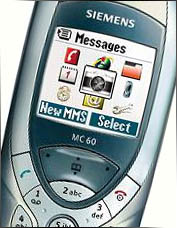Siemens Develops GSM Solution for Aircraft
12 July 2005 by axxxr Siemens has signed an exclusive contract with Airbus to jointly develop a solution for the use of in-flight communication via GSM.
Siemens will provide the GSM technology, while Airbus will take charge of its integration in the existing electronics systems. In addition, Airbus will be responsible for marketing the new solution to the airlines and for maintenance. The commercial launch of this new customer service is planned for 2006. This means Airbus will now be able to offer the customers of the airlines full-time availability while in the air. A decisive factor in Airbus's choice of Siemens as its partner in implementing this interesting service was the expertise of the company in realizing complex projects and innovative, customer-oriented technologies. With the integration of GSM, airline passengers will in future be able to use their own mobile devices for in-flight phone calls or Internet surfing. During business flights in particular, but on private journeys too, continuous availability is a decisive quality factor for many passengers. The GSM solution is implemented via a Siemens nano-GSM/GPRS base station on the airplane attached behind the ceiling panel, which allows reception for a mobile phone, PC or organizer from any seat on the plane. The Siemens nano-GSM base station is the smallest and lightest base station in the world. The product is based on IP and is linked to the terrestrial GSM mobile network with the aid of satellite technology. An important prerequisite for implementing the solution is the integration of channel selector technology. This technology prevents the end devices from establishing contact with terrestrial networks and hence interfering with the avionics . It therefore ensures that radio communication from the airplane is conducted solely via satellite . The new solution will be modular in structure so that it can be expanded to accommodate more GSM capacity and other technologies such as WLAN. "Being able to use their mobile phones onboard aircraft has long been the wish of many passengers who often travel on business flights and depend on mobile communication solutions", explained Christoph Caselitz, President of the business segment Mobile Networks at Siemens Communications. "We at Siemens are working hard on mobile enterprise solutions that carriers and service providers can make available to their customers through wireless technology. The partnership between Siemens and Airbus will ensure that this modern service is up and running soon and will open up new sources of revenue for the airlines. Comments On 20 Mar 12:17 Pharaoh wrote GSM On Aircraft Solution by Ericsson was developed and introduced in 2005. Monday, June 13 2005 Ericsson introduces its newly developed system GSM on Aircraft, allowing airplane passengers to use their mobile phones on board commercial aircrafts. Travelers of today demand full GSM access, also in flight. The demand is to reach and to be reachable. The time has come now when mobile phones also can and will be integrated into the commercial fleet of airliners. Ulf Ewaldsson, Vice President Product Management GSM says: "GSM is the largest mobile communications standard in the world and is used in every country. Consumers demand coverage anytime and anywhere. This is why Ericsson now is making mobile telephony available on board aircrafts and ships." Ericsson has developed an airborne version of the world's most sold radio base station in the RBS 2000 family, the RBS 2708. The new radio base station offers Ericsson state of the art quality and ease of operation. Its functionally is identical to terrestrial systems and it has a well-recognized reliability. For the traditional Ericsson customers - the telecom operators - the RBS 2708 will be 'just another cell' in the network. An operator can manage this system just as they handle all other radio base stations. Only a few special procedures will be required to operate this boost to revenues. Airlines will be able to offer an added-value service to their passengers. The ordinary aircraft crew can handle the GSM on Aircraft system, with a minimum of extra workload, and allow passengers to place and receive calls when at cruising altitude. Fully integrated with an Electromagnetic Screening Device (EMSD) and housed in an Avionics standard enclosure of ARINC 600 type, the equipment is easy to install and safe in operation: not interfering with neither avionics nor terrestrial radio networks. The system offers up to 60 simultaneous calls and also offers dual band support as an option. The system is available for installations late this year. Ericsson is shaping the future of Mobile and Broadband Internet communications through its continuous technology leadership. Providing innovative solutions in more than 140 countries, Ericsson is helping to create the most powerful communication companies in the world. |











 RSS feed
RSS feed